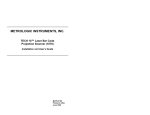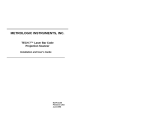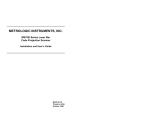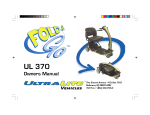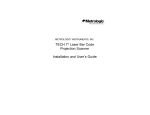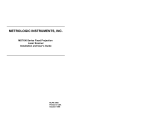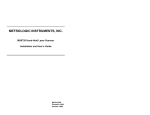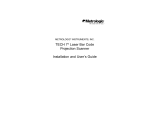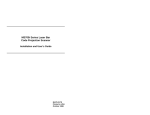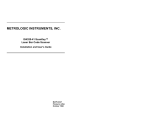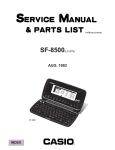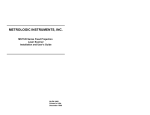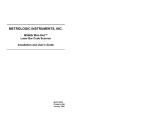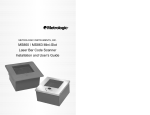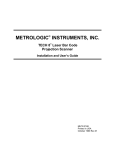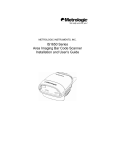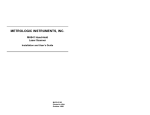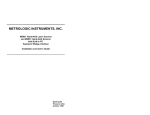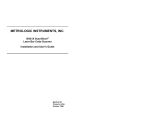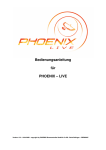Download Metrologic Instruments MLPN 2159 User's Manual
Transcript
METROLOGIC INSTRUMENTS, INC. TECH 7™ Laser Bar Code Projection Scanner Installation and User’s Guide MLPN 2159 Printed in USA June 1998 Locations: USA Corporate Headquarters Metrologic Instruments, Inc. 90 Coles Road Blackwood, NJ 08012 Customer Service: 1-800-ID-METRO Tel: 609-228-8100 Fax: 609-228-6673 EMAIL: [email protected] INTERNET: http://www.metrologic.com Mailing Address: P.O. Box 307 Bellmawr, NJ 08099-0307 South America Metrologic Instruments Centro Ciudad Comercial Tamanaco Torre B, piso 6, ofic. 603-B Chuao 1064 Caracas, Venezuela Tel: 58-2-959-8911 Fax: 58-2-959-9328 EMAIL: [email protected] Europe Metrologic Instruments GmbH Dornierstrasse 2 82178 Puchheim b. Munich, Germany Tel: 49-89-89019-0 Fax: 49-89-89019-200 EMAIL: [email protected] ASIA Metrologic Asia (PTE) Ltd. 31, Kaki Bukit Road 3 #05-08, Techlink Singapore 417818 Tel: 65-842-7155 Fax: 65-842-7166 EMAIL: [email protected] Brasil Metrologic do Brasil Ltda. Rua Florida, 1821-5 andar Brooklin-Sao Paulo-SP 04571-090 Brasil Tel: (011) 5505-2396 Fax: (011) 5507-2301 EMAIL: [email protected] Copyright © 1999 by Metrologic® Instruments, Inc. All rights reserved. No part of this work may be reproduced, transmitted, or stored in any form or by any means without prior written consent, except by reviewer, who may quote brief passages in a review, or provided for in the Copyright Act of 1976. Products and brand names mentioned in this document are trademarks of their respective companies. ii Table of Contents Introduction . . . . . . . . . . . . . . . . . . . . . . . . . . . . . . . . . . . . . . . . . . . . . . . . . . 1 Unpacking List . . . . . . . . . . . . . . . . . . . . . . . . . . . . . . . . . . . . . . . . . . . . . . . . 1 Scanner Installation . . . . . . . . . . . . . . . . . . . . . . . . . . . . . . . . . . . . . . . . . . . . . 2 Configuration to the Host System . . . . . . . . . . . . . . . . . . . . . . . . . . . . . . . . . . 3 Stand Installation . . . . . . . . . . . . . . . . . . . . . . . . . . . . . . . . . . . . . . . . . . . . . . . 4 Back Plate Installation . . . . . . . . . . . . . . . . . . . . . . . . . . . . . . . . . . . . . . . . . . 5 Parts of the Scanner . . . . . . . . . . . . . . . . . . . . . . . . . . . . . . . . . . . . . . . . . . . . . 6 Visual Indicators . . . . . . . . . . . . . . . . . . . . . . . . . . . . . . . . . . . . . . . . . . . . 7-10 Labels . . . . . . . . . . . . . . . . . . . . . . . . . . . . . . . . . . . . . . . . . . . . . . . . . . . . . . . 11 Depth of Scan Field for the MS770 Scanner . . . . . . . . . . . . . . . . . . . . . . . . 12 Depth of Scan Field for the MS775 Scanner . . . . . . . . . . . . . . . . . . . . . . . . 13 Applications and Protocols . . . . . . . . . . . . . . . . . . . . . . . . . . . . . . . . . . . . . . 14 Maintenance . . . . . . . . . . . . . . . . . . . . . . . . . . . . . . . . . . . . . . . . . . . . . . . . . . 14 Appendix A Specifications . . . . . . . . . . . . . . . . . . . . . . . . . . . . . . . . . . . . . . 15, 16 Appendix B Pin Assignments . . . . . . . . . . . . . . . . . . . . . . . . . . . . . . . . . . . . 17, 18 Appendix C Warranty and Disclaimer . . . . . . . . . . . . . . . . . . . . . . . . . . . . . 19, 20 Appendix D Notices . . . . . . . . . . . . . . . . . . . . . . . . . . . . . . . . . . . . . . . . . . . 21, 22 Appendix E Patents . . . . . . . . . . . . . . . . . . . . . . . . . . . . . . . . . . . . . . . . . . . . . . . 23 Index . . . . . . . . . . . . . . . . . . . . . . . . . . . . . . . . . . . . . . . . . . . . . . . . . . . . 24, 25 iii Introduction Metrologic’s TECH 7 laser bar code projection scanner is encased in an NEMA-12 steel case. The case construction enables the scanner to operate in harsh surroundings, especially industrial environments. Water-resistant, shock-resistant, and rugged, the TECH 7 is also fast, aggressive and reliable. It can register bar codes at a range of 76mm - 254mm (3" - 10") and can autodiscriminate among all common codes. To suit particular applications, two different scan patterns are available: an omnidirectional pattern of 20 interlocking lines (Model MS770); or a 12-line raster pattern (Model MS775). The scanner has a VLD design, a scan speed of up to 2000 lines per second, and uses less than 8 watts of power. Other features include an Application Specific Integrated Circuit (ASIC) and MECCA© (Metrologic Enhanced Code Correcting Algorithm). An Application Specific Integrated Circuit (ASIC) is in the decoding system and virtually eliminates misreads. MECCA© (Metrologic Enhanced Code Correcting Algorithm) enables the TECH 7 scanner to read poorly printed, wrinkled or even torn bar codes on the first pass. Unpacking List The shipping carton, should contain the following: ! Installation and User’s Guide (MLPN: 2159) ! ScanSelect Scanner Programming Guide (MLPN: 2186) ! TECH 7 Model MS770 with omnidirectional scan pattern or TECH 7 Model MS775 with raster scan pattern ! Communication Cable with Power Supply (optional) or Communication Cable (optional) ! Back Plate (optional) or Stand (optional) If any item is missing or to order additional items, contact the dealer, distributor or call Metrologic’s Customer Service Department at 1-800-IDMETRO or 1-800-436-3876. 1 Scanner Installation To maintain compliance with applicable standards, all circuits connected to the scanner must meet the requirements for SELV (Safety Extra Low Voltage) according to EN 60950. To avoid potential problems, do not power up the scanner until the communication cable is secured to the host. 1. "Power off" the host system. 2. Locate the 19-pin female end of the scanner link cable and find the widest key located above pins L and A. Align this key with the corresponding key on the scanner box’s Mil spec connector. While pushing in on the connector, rotate the ring clockwise until it locks into place with a click. 3. Connect the other end of the communication cable to the host device. (If the scanner is powered by the host, skip to Step 5.) 4. Check the AC input requirements of the transformer/power supply to make sure the voltage matches an available AC outlet. Plug the transformer into the AC outlet to supply power to the scanner. (A socket-outlet shall be installed near the equipment and shall be easily accessible.) 5. "Power up" the host system. Note: When the scanner first receives power, the LEDs will flash and then the scanner will beep once. After the scanner performs this startup sequence, the green LED will remain on for a specified time indicating that the laser is on. 2 Configuration to the Host System The scanner is shipped from the factory programmed to a set of default conditions noted in the ScanSelect Scanner Programming Guide by an asterisk that appears before the brief definition located next to the bar code. In order for the scanner to communicate with a host system properly, it may need to be programmed. Since each host system is unique, configure the scanner to match the host system requirements. Configure the scanner by entering the program mode and scanning the appropriate bar codes that appear in the ScanSelect Scanner Programming Guide. (To use ScanSet™, refer to the ScanSet documentation for information on how to configure a scanner.) 1. Connect the scanner to the host system (Refer to the Scanner Connections to the Host section in this guide). 2. Enter program mode by scanning the ENTER/EXIT program mode bar code. (The unit will beep three times) 3. Scan the appropriate bar code(s) that appear in the ScanSelect Scanner Programming Guide. (Reveal only one bar code to the scanner each time. With your hand, cover the bar code not to be scanned.) 4. Exit program mode by scanning the ENTER/EXIT program mode bar code again. (The new options will be saved and the scanner is ready for normal operation.) 3 Stand Installation With the Metrologic stand (Part #45475), the scanner can be positioned in one of two directions. The two orientation choices are vertical or horizontal. (Refer to Figure 1) To install this stand, use the four 632 x ½ inch machine screws and two #10 panhead wood screws. 1. Drill two holes into the work surface that are the same size and distance as the holes on the stand base. (Refer to Figure 2) Figure 1 Base of Stand 2. Use the two #10 panhead wood screws to attach the stand to the work surface. Figure 2 3. To fasten the scanner: ! For a horizontal mount, align the four holes on the back of the scanner with the four clearance holes located on the stand marked with an X in Figure 3. ! For a vertical mount, align the four holes on the back of the scanner with the four clearance holes located on the stand marked with a Y in Figure 3. Figure 3 4. Fasten the scanner to the stand by inserting the four 6-32 x ½ inch screws into the four holes in the scanner’s case. 4 Back Plate Installation With the Metrologic back plate (Part #45473), position the scanner in one of two directions. The two orientation choices are vertical or horizontal. (Refer to Figure 4). To use this stand, use the four 6-32 x ½ inch machine screws and four wood screws to attach the unit to the back plate and work surface. The maximum distance the screws should go into the scanner is a ½ inch. Figure 4 1. Drill four holes into the work surface that correspond with the holes indicated by an XY in Figure 5. 2. To fasten the scanner to the back plate: ! For a horizontal mount, align the four holes on the back of the scanner with the four clearance holes located on the back plate marked with an X in Figure 5. ! For a vertical mount, align the four holes on the back of the scanner with the four clearance holes located on the back plate marked with a Y in Figure 5. 3. Fasten the scanner to the back plate by inserting the four 6-32 x ½ inch screws into the four holes in the scanner’s case. Fasten the scanner and back plate to the work surface. Figure 5 5 Parts of the Scanner 1 Green and Red LEDs 2 Speaker 3 Laser Output Window 4 Mil spec Connector Figure 6 6 1 Green and Red LEDs When the green LED is on, this indicates that the unit is receiving power and the laser is on. When the red LED flashes on, the scanner has read a bar code successfully. When the red light turns off, communica-tion to the host is complete. 2 Speaker The speaker emits a beep when a bar code has been decoded. 3 Laser Output Window This aperture emits the laser light. 4 Mil spec Connector The 19-pin male Mil spec connector was designed to connect a communi cation cable from the scanner to a host device. The communication cable may include a power supply or it may be de signed to draw power directly from the host device. The standard TECH 7 has one connector. (When atrium option is installed, a second connector is installed on the unit to connect the MX001 Industrial Control Interface box.) Visual Indicators There is a red and green LED at the top of the scanner. When the scanner is on, the flashing or stationary activity of the LEDs indicates the status of the scan and scanner. Steady Green When the laser is on, the green LED is also on. This occurs when an object is in the scan field. Steady Green; Red Flash When the scanner successfully reads a bar code, the red LED will flash then beep once. If the red LED does not flash or the scanner does not beep once, then the bar code has not been successfully read. Steady Red and Green After a successful scan, the scanner transmits the data to the host device. When the host is not ready to accept the information, the scanner’s red LED will remain on until the data can be transmitted. Alternating Red and Green This indicates the scanner is in program mode. Steady Red This indicates the scanner is in ScanSet mode. No Red or Green LED There are two reasons why the LEDs will not be illuminated. First, if the scanner is receiving power and the LEDs are not on, then the scanner has remained dormant for a specified time and the laser has turned off. To reactivate the unit, touch the touch plate. Secondly, if the scanner is not receiving power from the host or transformer, then the LEDs will not turn on. Flashing Red This indicates the scanner has experienced a laser subsystem failure. Return the unit for repair at an authorized service center. 7 Signaux optiques Sur la partie supérieure du scanner se trouvent une diode LED rouge et une diode LED verte. Quand le scanner est sous tension, les diodes rouge et verte clignotantes ou allumées vous informent sur l'état du scanner. Ni la diode rouge, ni la diode verte n'est allumée Il existe deux raisons possibles pour que les diodes ne s'allument pas. Premièrement: si le scanner reçoit de l'énergie sans que les diodes ne s'allument, le scanner est resté sans servir pendant une certaine période et le laser est désactivé. Pour le réactiver, passer un objet devant le palpeur infrarouge. Deuxièmement: quand le scanner ne reçoit de l'énergie ni de l'ordinateur central, ni du transformateur, les diodes restent éteintes. La diode verte reste allumée Quand le laser est en service, la diode verte s'allume également. C'est le cas quand un objet se trouve devant le palpeur. La diode verte reste allumée tant que la temporisation de l'infrarouge dure ou jusqu'à ce que le scanner soit désactivé. La diode verte reste allumée; la diode rouge clignote Après lecture avec succès d'un code à barres par le scanner, la diode rouge se met à clignoter, suivie d'un bip sonore unique. Si la diode rouge ne clignote pas ou quand aucun bip sonore n'est émis, cela signifie que le code à barres n'a pas pu être lu avec succès. Les diodes rouges et vertes restent allumées Une fois la lecture effectuée avec succès, le scanner transmet les données à l'ordinateur central. Si ce dernier n'est pas prêt à recevoir les données, la diode rouge du scanner reste allumée jusqu'à ce que les données puissent être transmises. Les diodes rouges et vertes clignotent en alternance Indique que le scanner se trouve en mode de programmation. La diode rouge reste allumée Indique que le scanner se trouve en mode ScanSet. Diode rouge clignotante Indique une panne de laser pendant la lecture. Veuillez envoyer votre appareil chez unconcessionnaire pour réparation. 8 Optische Anzeigen Auf dem Scanner befinden sich eine rote und eine grüne Leuchtdiode. Bei eingeschaltetem Scanner geben Ihnen die blinkenden bzw. feststehenden Leuchtdiodenanzeigen Aufschluß über den Abtast- und Scannerstatus. Weder rote noch grüne Leuchtdiodenanzeige Es gibt zwei mögliche Gründe, weshalb die Leuchtdiodenanzeigen nicht aufleuchten. Erstens: Wenn der Scanner mit Energie versorgt wird und die Leuchtdiodenanzeigen nicht aufleuchten, so ist der Scanner für einen bestimmten Zeitraum untätig geblieben, und der Laser ist abgeschaltet. Zur Reaktivierung der Einheit sollten Sie ein Objekt vor dem Infrarot-Sensor hin- und herbewegen. Zweitens: Wenn der Scanner weder vom Hostrechner noch vom Transformator Energie erhält, so leuchten die Leuchtdiodenanzeigen nicht auf. Feststehende grüne Anzeige Wenn der Laser in Betrieb ist, leuchtet die grüne Leuchtdiodenanzeige ebenfalls auf. Dies ist dann der Fall, wenn sich ein Objekt im Abtastfeld befindet. Die grüne Leuchtdiodenanzeige leuchtet solange auf, bis das Infrarot-Timeout abgelaufen ist, oder bis der Scanner abgeschaltet wird. Feststehende grüne Leuchtanzeige; rote Blinkanzeige Nach erfolgreichem Lesen eines Barcodes durch den Scanner blinkt die rote Leuchtdiodenanzeige auf, gefolgt von einem einmaligen Piep-Signal. Blinkt die rote Leuchtdiodenanzeige nicht auf oder sendet der Scanner kein Piep-Signal aus, so konnte der Barcode nicht erfolgreich gelesen werden. Feststehende rote und grüne Leuchtanzeige Nach erfolgreichem Abtasten überträgt der Scanner die Daten an das Hostgerät. Falls das Hostgerät zur Datenannahme nicht bereit ist, leuchtet die rote Leuchtdiodenanzeige des Scanners solange auf, bis die Daten übertragen werden können. Alternierende rote und grüne Leuchtanzeige Zeigt an, daß sich der Scanner im Programmiermodus befindet. Feststehende rote Leuchtanzeige Zeigt an, daß sich der Scanner im ScanSet-Modus befindet. Aufblinkende rote Leuchtanzeige Zeigt an, daß beim Scanner ein Laserausfall vorliegt. Bringen Sie das Gerät zur Reparatur in ein Vertragsservicecenter. 9 Segnali ottici Sullo scanner si trovano due diodi luminosi: uno rosso e uno verde. Quando lo scanner è inserito, i diodi luminosi, che possono o essere accesi in continuazione o lampeggiare, Vi informano sullo stato della scansione e dell’apparecchio. Né il diodo luminoso rosso né quello verde sono accesi Vi sono due possibili cause se i diodi luminosi non sono accesi. Prima causa: se lo scanner viene alimentato e i diodi luminosi non sono accesi, lo scanner è rimasto disattivato per un determinato periodo e il laser è spento. Per riattivare l’unità dovreste muovere un oggetto davanti al sensore a infrarossi. Seconda causa: se lo scanner non viene alimentato né dal calcolatore host né dal trasformatore, i due diodi luminosi non sono accesi. Il diodo luminoso verde è acceso Quando il laser è inserito, è acceso anche il diodo luminoso verde. Questo si ha quando un oggetto si trova nella zona di scansione. Il diodo luminoso verde è acceso fino al raggiungimento del timeout infrarossi oppure fino allo spegnimento dello scanner. Il diodo luminoso verde è acceso; quello rosso lampeggia Dopo la lettura riuscita di un codice a barre da parte dello scanner il diodo luminoso rosso lampeggia e quindi viene emesso un unico segnale beep. Se il diodo luminoso rosso non lampeggia oppure lo scanner non emette un segnale beep, ciò significa che la lettura del codice a barre non è riuscita. Sono accesi sia il diodo luminoso rosso che quello verde Dopo la scansione riuscita lo scanner trasmette i dati all’host. Se l’host non è pronto per accettare i dati, il diodo luminoso rosso dello scanner è acceso fino a che i dati possono essere trasmessi. Il diodo luminoso rosso e quello verde sono accesi in alternanza Ciò indica che lo scanner si trova nella modalità di programmazione. Il diodo luminoso rosso è acceso Ciò indica che lo scanner si trova nella modalità ScanSet. Il diodo luminoso rosso lampeggia Ciò indica che lo scanner ha un guasto a livello del laser. Fate riparare l’apparecchio da un centro di assistenza autorizzato. 10 Labels There is one label located inside the window of the scanner noting that this device is a CDRH Class IIa laser product and IEC 825 LASERKLASSE 1. Also, on the scanner is a label located on the back of the unit. This label contains information such as the model number, date of manufacture, serial number, and approvals. The following are samples of the labels located on the unit. 11 Depth of Scan Field for the MS770 Scanner The depth of field for the scanner is 76mm to 254mm (3" - 10") from the laser output window. Pass the symbol through the scan area in order for the scanner to recognize the bar code. (Refer to Figure 7) Figure 7 12 Depth of Scan Field for the MS775 Scanner The depth of field for the scanner is 76mm to 254mm (3" - 10") from the laser output window. Pass the symbol through the scan area in order for the scanner to recognize the bar code. (Refer to Figure 8) Figure 8 13 Maintenance Smudges and dirt can interfere with the proper scanning of a bar code. Therefore, the output window will need occasional cleaning. 1. Spray glass cleaner onto lint free, nonabrasive cleaning cloth. 2. Gently wipe the output window. Applications and Protocols The model number on each scanner includes the scanner number and communications protocol. Version Identifier 1 15 14 Communication Protocol(s) RS-232, OCIA, Bidirectional RS-232 Light Pen Emulation Appendix A Specifications Application: Light Source: Laser Class: Certifications: EMC: Industrial Projection Scanner Visible Laser Diode 670 ± 5nm, CDRH: CLASS IIa; EN 60825 Class 1 CE, UL listed for US and Canada FCC Class A, CISPR Class A Mechanical Dimensions: Weight: Orientation: Mounting: Top Cover: Host Cable Length: 184mmL x 186mmW x 78mmD (7.25"L x 7.3"W x 3.06"D) 2.35 kg. (5.19 lbs.) without cable May be used in any orientation Back plate mount or Vertical stand NEMA-12 steel case 1.83m (6') cable with mil spec connector Electrical Power Consumption: Input Voltage: Operating Current: Standby Current: DC Transformers: 8 watts, host system or wall transformer 11-30 VDC 420mA typical @ 20V 210mA typical @ 20V 120V (AC in), 230V (AC in), 240V ( AC in); output 20V @ 750mA Patents Pending Specifications subject to change without notice. 15 Operational Depth of Scan Field: Scan Speed: Scan Pattern: Indicators: Beeper Operation: Maintenance Required: Decode Capability: System Interfaces: Optional: Print Contrast: Roll, Pitch, Yaw: 76mm to 254mm (3" to 10") Model 770: 2000 scan lines per second Model 775: 1200 scan lines per second Model 770: Omnidirectional (20 interlocking lines) Model 775: 12-line raster LED: green = laser on; red = good read Selection of 3 tones for “Good Read” Clean window periodically Autodiscriminates RS232C; Light Pen Emulation; OCIA Opto coupled 6 amps US and Canada, 5 amps EEA countries TRIAC output; object sensor input 35% minimum reflectance difference 360E, 60E, 60E Environmental Storage Temperature: Operating Temperature: Humidity: Light Levels: Ventilation: Shock: ESD: Contaminants: -40EC to 60EC (-40EF to 140EF) 0EC to 35EC (32EF to 95EF) 5% to 95% relative humidity, non-condensing Up to 3200 foot candles - works in direct sun None required 100g for 1ms 8 kV IEC 801-2 Protects against dust, falling dirt, and dripping non-corrosive liquid Specifications subject to change without notice. 16 Appendix B Pin Assignments Version “1” Pin Assignments for RS-232, OCIA, and Bidirectional RS-232 Each TECH 7 scanner has a 19-pin male Mil spec connector that is located on the side of the unit. To connect the scanner to the host device, use a communication cable with a female Mil spec connector. The communication cable may include a power supply or it may be designed to draw power directly from the host device. This item can be ordered when the scanner is purchased. The Version “1” scanner is designed to be used for RS-232, OCIA, and RS-232 with limited receiving capabilities. The following is a list of pin assignments. The pin numbers are impressed on the male Mil spec connector. For easier reference, refer to Figure 9 for pin locations. Pin Function A B C D E F G H J K L M N P R S R Data RTS Output Signal Ground CTS Input R Data Return RS-232 Output Clock in Clock in Return Clock Out Shield Ground DTR Input Clock Out Return Power to Scanner & 24 VDC Earth Ground Power Ground RS-232 Input Figure 9 17 Version “15” Pin Assignments for Light Pen Emulation Each TECH 7 scanner has a 19-pin male Mil spec connector that is located on the side of the unit. To connect the scanner to the host device, use a communication cable with a female Mil spec connector. The communication cable may include a power supply or it may be designed to draw power directly from the host device. This item can be ordered when the scanner is purchased. The Version “15” scanner is designed to be used for Light Pen Emulation communication. The following is a list of pin assignments. The pin numbers are impressed on the male Mil spec connector. For easier reference, refer to Figure 10 for pin locations. Pin A B C D E F G H J K L M N P R S 18 Function R Data Light Pen Data Output Signal Ground Light Pen Source & 5 VDC R Data Return RS-232 Output Clock in Clock in Return Clock Out Shield Ground DTR Input Clock Out Return Power to Scanner & 24 VDC Earth Ground Power Ground RS-232 Input Figure 10 Appendix C Warranty and Disclaimer Limited Warranty Products manufactured by Metrologic have a 2-year limited warranty from date of manufacture. This warranty is limited to repair, replacement or refund at Metrologic’s discretion. Faulty equipment must be returned to the Metrologic facility in Blackwood, New Jersey or Puchheim, Germany. To do this, contact Metrologic Customer Service/Repair for a Returned Material Authorization (RMA) number. In the event that it is determined that the equipment failure is covered under the warranty, Metrologic shall, as its sole option, repair, replace with a functionally equivalent unit, or refund an amount equal to the purchase price to the original purchaser, whether distributor, dealer/reseller, or retail consumer, and return the equipment to the customer without charge for service or return freight. This limited warranty does not extend to any Product which, in the sole judge-ment of Metrologic, has been subjected to misuse, neglect, improper installation or accident, nor does it extend to any Product which has been repaired or altered by anyone who is not a Metrologic authorized representative. THIS LIMITED WARRANTY, EXCEPT AS TO TITLE, IS IN LIEU OF ALL OTHER WARRANTIES, EXPRESS OR IMPLIED, INCLUDING MERCHANTABILITY OR FITNESS FOR ANY PARTICULAR PURPOSE, ARISING BY LAW, CUSTOM OR CONDUCT. THE RIGHTS AND REMEDIES PROVIDED HEREIN ARE EXCLUSIVE AND IN LIEU OF ANY OTHER RIGHTS OR REMEDIES. IN NO EVENT SHALL METROLOGIC BE LIABLE FOR INDIRECT, INCIDENTAL, OR CONSEQUENTIAL DAMAGES, INCLUDING, WITHOUT LIMITATION, ANY INJURY TO PROPERTY OR PERSON OR EFFECT ON BUSINESS OR PROFIT, AND IN NO EVENT SHALL ANY LIABILITY OF METROLOGIC EXCEED THE ACTUAL AMOUNT PAID TO METROLOGIC FOR THE PRODUCT. Metrologic Instruments, Inc. 90 Coles Road Blackwood, NJ 08012 Customer Service Department 1-800-ID-METRO (1-800-436-3876) TEL: 609-228-8100 FAX: 609-228-6673 Metrologic Instruments GmbH Dornierstrasse 2 82178 Puchheim b. Munich, Germany TEL: 49-89-89019-0 FAX: 49-89-89019-200 19 Disclaimer Metrologic Instruments, Inc. and the author or authors make no claims or warranties with respect to the contents or accuracy of this publication, or the product it describes, including any warranties of fitness or merchantability for a particular purpose. Any stated or expressed warranties are in lieu of all obligations or liability for any damages, whether special, indirect, or consequential, arising out of or in connection with the use of this publication or the product it describes. Furthermore, the right is reserved to make any changes to this publication without obligation to notify any person of such changes. Metrologic also reserves the right to make any changes to the product described herein. Exclusion des responsabilités Metrologic Instruments, Inc. et le/les auteur(s) ne sont ni garants, ni responsables pour l'exhaustivité et la correction des informations contenues dans cette brochure - que ce soit relativement à leur teneur et à l' exactitude - ou pour le produit qui y est décrit. Ils ne sont en outre responsables d'aucune garantie de propriété ou de qualité pour un usage particulier. Toutes les assurances nommées ou exprimées excluent toute garantie ou responsabilité pour les dommages spéciaux, indirects ou des suites de l'utilisation de cette brochure ou du produit qui y est décrit respectivement. en rapport avec l'emploi de cette brochure et du produit qui y est décrit. Il leur est également réservé le droit de procéder à des modifications de cette brochure sans avoir à en avertir qui que ce soit. Metrologic se réserve en outre le droit de procéder à des modifications du produit qui y est décrit. Haftungsausschluß Metrologic Instruments, Inc. und der/die Autor(en) übernehmen keinerlei Gewähr und haften nicht für die Richtigkeit im Hinblick auf Inhalt oder Genauigkeit der Angaben dieser Veröffentlichung oder des hierin beschriebenen Produkts. Sie übernehmen ebenso keinerlei Eignungsgarantie oder Gewährleistung durchschnittlicher Qualität für einen bestimmten Zweck. Alle benannten oder ausdrücklichen Zusicherungen schließen sämtliche Verpflichtungen oder Haftungen aus jeglichem Schaden aus, ganz gleich ob speziell, indirekt oder als Folge der Verwendung dieser Veröffentlichung oder des hierin beschriebenen Produkts bzw. in Zusammenhang mit der Verwendung dieser Veröffentlichung oder des hierin beschriebenen Produkts. Darüber hinaus wird das Recht vorbehalten, Änderungen an dieser Veröffentlichung vorzunehmen ohne die Verpflichtung, irgend jemanden über solche Änderungen zu unterrichten. Metrologic behält sich ferner das Recht vor, Änderungen an dem hierin beschriebenen Produkt vorzunehmen. Esclusione della responsabilità La Metrologic Instruments, Inc. e l’autore/gli autori non assumono nessuna garanzia e non rispondono della correttezza per quanto riguarda il contenuto o la precisione di quanto indicato nel presente Manuale o del prodotto in esso descritto. Neppure essi assumono una garanzia per l’idoneità o una garanzia della qualità media per un determinato scopo. Tutte le garanzie citate o fatte espressamente escludono qualsiasi obbligo o responsabilità derivanti da qualsiasi danno, indipendentemente dal fatto che questo obbligo/questa responsabilità risulti in particolare, indirettamente o come conseguenza dall’uso del presente Manuale o del prodotto in esso descritto oppure se è legato/a all’uso del presente Manuale o del prodotto in esso descritto. Inoltre ci si riserva il diritto di modificare il presente Manuale senza essere obbligati ad informare persona alcuna circa dette modifiche. Metrologic si riserva il diritto di apportare modifiche al prodotto descritto nel presente Manuale. 20 Appendix D Notices Notice This equipment has been tested and found to comply with limits for a Class A digital device, pursuant to Part 15 of the FCC Rules. These limits are designed to provide reasonable protection against harmful interference when the equipment is operated in a commercial environment. This equipment generates, uses and can radiate radio frequency energy and, if not installed and used in accordance with the instruction manual, may cause harmful interference to radio communications. Operation of this equipment in a residential area is likely to cause harmful interference, in which case the user will be required to correct the interference at his own expense. Any unauthorized changes or modifications to this equipment could void the users authority to operate this device. Notice This digital apparatus does not exceed the Class A limits for radio noise emissions from digital apparatus set out in the Radio Interference Regulations of the Industry and Canada. Caution Use of controls or adjustments or performance of procedures other than those specified herein may result in hazardous laser light. Under no circumstances should the customer attempt to service the laser scanner. Never attempt to look at the laser beam, even if the scanner appears to be nonfunctional. Never open the scanner in an attempt to look into the device. Doing so could result in hazardous laser light exposure. The use of optical instruments with the laser equipment will increase eye hazard. Remarque Après contrôle de cet appareil, on a noté qu'il répondait aux valeurs limites de la classe A, conformément à la partie 15 des directives de l'administration fédérale américaine pour les télécommunications. Ces valeurs limites ont été prévues pour garantir une protection suffisante contre les effets nocifs dus à l'emploi de l'appareil dans un magasin. L'appareil génère et utilise une énergie haute fréquence et peut, s'il n'est pas installé et utilisé conformément aux instructions mentionnées dans le guide d'utilisation, entraîner des perturbations dans la radiocommunications. L'utilisation de cet appareil dans une zone d'habitation entraînera très vraisemblablement des perturbations. Dans ce cas, l'utilisateur est tenu de remédier à ces perturbations à ses propres frais. Toute modification ou remplacement non autorisé sur cet appareil peut entraîner l'invalidité de l'autorisation d'utilisation de l'appareil. Remarque Cet appareil numérique ne va pas contre les valeurs limites pour émissions de bruits radios des appareils numérique de la classe A, conformément aux directives relatives aux perturbations des radiocommunications du ministère canadien pour l'industrie. Attention L'emploi de commandes, réglages ou procédés autres que ceux décrits ici peut entraîner de graves irradiations. Le client ne doit en aucun cas essayer d'entretenir lui-même le scanner ou le laser. Ne regardez jamais directement le rayon laser, même si vous croyez que le scanner est inactif. N'ouvrez jamais le scanner pour regarder dans l'appareil. Ce faisant, vous vous exposez à une rayonnement laser mortel. L'emploi d'appareils optiques avec cet équipement laser augmente le risque d'endommagement de la vision. 21 Anmerkung Nach Überprüfung dieses Geräts wurde festgestellt, daß es den Grenzwerten für Digitalgeräte der Klasse A gemäß Teil 15 der Richtlinien der US-amerikanischen Bundesbehörde für das Fernmeldewesen entspricht. Diese Grenzwerte wurden festgelegt, um einen angemessenen Schutz gegen schädliche Auswirkungen bei Einsatz des Geräts in einer Ladenumgebung zu gewähren. Das Gerät erzeugt und verwendet Hochfrequenzenergie und kann diese ausstrahlen, und kann, falls es nicht gemäß den im Bedienerhandbuch enthaltenen Anweisungen installiert und verwendet wird, zu einer Störung des Funkverkehrs führen. Der Betrieb dieses Geräts in einem Wohngebiet führt höchstwahrscheinlich zu Störungen. In diesem Fall ist der Bediener verpflichtet, die Störung auf eigene Kosten zu beseitigen. Durch jegliche unerlaubte Auswechselung oder Änderung an diesem Gerät könnte die Genehmigung des Bedieners zur Verwendung dieses Geräts ungültig werden. Anmerkung Dieses Digitalgerät verstößt nicht gegen die Grenzwerte für Funkrauschemissionen von Digitalgeräten der Klasse A gemäß den Richtlinien für Funkstörungen des kanadischen Ministeriums für Industrie. Achtung Die Verwendung anderer als der hierin beschriebenen Steuerungen, Einstellungen oder Verfahren kann eine lebensgefährliche Laserstrahlung hervorrufen. Der Kunde sollte unter keinen Umständen versuchen, den Laser-Scanner selbst zu warten. Sehen Sie niemals in den Laserstrahl, selbst wenn Sie glauben, daß der Scanner nicht aktiv ist. Öffnen Sie niemals den Scanner, um in das Gerät hineinzusehen. Wenn Sie dies tun, können Sie sich einer lebensgefährlichen Laserstrahlung aussetzen. Der Einsatz optischer Geräte mit dieser Laserausrüstung erhöht das Risiko einer Sehschädigung. N.B. Dal controllo di questo apparecchio risulta che esso risponde ai valori limite per apparecchi digitali della classe A conf. parte 15 delle direttive sulle telecomunicazioni dell’Autorità federale statunitense. Questi valori limite sono stati fissati per garantire una protezione adeguata contro gli effetti nocivi se questo apparecchio viene usato all’intero di un negozio. L’apparecchio genera, utilizza e può emettere energia ad alta frequenza e, se non viene installato ed utilizzato conformemente alle indicazioni fornite nel Manuale utente, può provocare disturbi al servizio radiofonico. L’uso di questo apparecchio in zone residenziali causa molto probabilmente dei disturbi. In questo caso l’utente è obbligato ad eliminare questi disturbi a sue spese. Qualsiasi sostituzione o modifica non autorizzata all’apparecchio potrebbe rendere invalida l’autorizzazione dell’utente all’uso dell’apparecchio. N.B. Questo apparecchio digitale non supera I valori limite per l’emissione di radiorumori da parte di apparecchi digitali della classe A conformemente alle direttive per radiodisturbi del Ministero canadese per l’Industria. Attenzione L’utilizzo di sistemi di controllo, di regolazioni o di procedimenti diversi da quelli decritti nel presente Manuale può provocare dei raggi laser pericolosi per la vita. Il cliente non deve assolutamente tentare di riparare egli stesso lo scanner laser. Non guardate mai nel raggio laser, anche se credete che lo scanner non sia attivo. Non aprite mai lo scanner per guardare dentro l’apparecchio. Se tuttavia lo fate, potete esporVi a dei raggi laser pericolosi per la vita. L’uso di apparecchi ottici con questo equipaggiamento laser aumenta il rischio di danni alla vista. 22 Appendix E Patents “Patent Information This METROLOGIC product may be covered by one or more of the following U.S. Patents: U.S. Patent No. 4,360,798; 4,369,361; 4,387,297; 4,460,120; 4,496,831; 4,593,186; 4,607,156; 4,673,805; 4,736,095; 4,758,717; 4,816,660; 4,845,350; 4,896,026; 4,923,281; 4,933,538; 4,992,717; 5,015,833; 5,017,765; 5,059,779; 5,117,098; 5,124,539; 5,130,520; 5,132,525; 5,140,144; 5,149,950; 5,180,904; 5,200,599; 5,229,591; 5,247,162; 5,250,790; 5,250,791; 5,250,792; 5,262,628; 5,280,162; 5,280,164; 5,304,788; 5,321,246; 5,324,924; 5,396,053; 5,396,055; 5,408,081; 5,410,139; 5,436,440; 5,449,891; 5,468,949; 5,479,000; 5,532,469; 5,545,889 No license right or sublicense is granted, either expressly or by implication, estoppel, or otherwise, under any METROLOGIC or third party intellectual property rights (whether or not such third party rights are licensed to METROLOGIC), including any third party patent listed above, except for an implied license only for the normal intended use of the specific equipment, circuits, and devices represented by or contained in the METROLOGIC products that are physically transferred to the user, and only to the extent of METROLOGIC’s license rights and subject to any conditions, covenants and restrictions therein.” 23 Index A AC 2, 15 Application 15 Application and protocols Asia ii ASIC 1 Europe ii 14 B Back plate hortizontal mount 5 vertical mount 5 Bar code(s) 1, 3, 6, 7, 12-14 Beep 2, 3, 6, 7, 10, 16 Beeper operation 16 C Cable F Faulty equipment 19 Fax ii G Germany (GmbH) Good read 16 Green LED 2, 6, 7 ii, 19 H Headquarters ii Host 2, 3, 6, 7, 9, 10, 15, 17, 18 Humidity 16 communication 1, 2, 6, 17, 18 length 15 CDRH class IIa 11 Clean 14, 16 Communication protocol 14 Compliance 2 Configuration 3 Contrast 16 Copyright ii Current 15 Customer Service ii, 19 D Depth of field Dimensions Disclaimer E Electrical EMI 15 Email ii Environmental ESD 16 24 12, 13 15 20 15 16 I IEC 825 LASERKLASSE 1 11 Indicators LED 2, 6, 7, 16 Visual 4-10 Interfaces 14, 16 Installation Back plate 5 Scanner 2 Stand 4 Internet ii Introduction 1 L Labels 11 LEDs 2, 6, 7, 16 Light levels 16 Light pen emulation 16, 18 Light source 15 Limited warranty 19 List 1 Locations ii 14, M Maintenance 14, 16 MECCA 1 Mechanical 15 Mil spec connector 15, 17, 18 Model number 11, 14 Mounting 4, 5, 15 MS770 1, 12 MS775 1, 13 N NEMA-12 steel case Notices 21, 22 2, 6, 1, 15 O OCIA 14, 16, 17 Operating current 15 Operating temperature 16 Operation 3, 16 Operational 16 Output window 6, 12-14, 16 P Parts 6 Patents 23 Print contrast 16 Programming guide Protocols 14 R Red LED 6, 7 Repair 19 Rights property 23 warranty 19 RMA 19 Roll, pitch, yaw 16 RS-232 14, 16-18 Scan field 12, 13, 16 Scan lines 16 Scan pattern 1, 16 Scan speed 1, 16 ScanSelect 1, 3 ScanSet 3, 7-9 Service 19 Shipping carton 1 Shock 16 South America ii Speaker 6 Specifications 15, 16 Stand 1, 4, 5, 15 hortizontal mount 4 vertical mount 4 Storage temperature 16 System interfaces 16 T Temperature Tones 16 Transformer 16 2, 7, 15 U UL/CSA/TUV/CE 15 USA corporate headquarters ii 1, 3 V Ventilation 16 Version “1" 17 Version “15" 18 Version identifiers Voltage 2, 15 14 W Warranty 19 Watts 1, 15 Weight 15 Window 6, 12-14, 16 S 25
This document in other languages
- français: Metrologic Instruments MLPN 2159
- italiano: Metrologic Instruments MLPN 2159




























